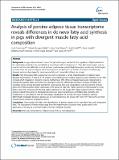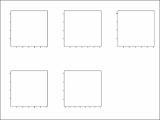Por favor, use este identificador para citar o enlazar a este item:
http://hdl.handle.net/10261/94765COMPARTIR / EXPORTAR:
 SHARE
BASE SHARE
BASE
|
|
| Visualizar otros formatos: MARC | Dublin Core | RDF | ORE | MODS | METS | DIDL | DATACITE | |

| Título: | Analysis of porcine adipose tissue transcriptome reveals differences in de novo fatty acid synthesis in pigs with divergent muscle fatty acid composition |
Autor: | Corominas, Jordi CSIC; Ramayo-Caldas, Yuliaxis; Puig-Oliveras, Anna CSIC ORCID; Estellé, Jordi; Castelló, Anna CSIC ORCID; Alves, Estefania; Pena, Ramona N.; Ballester, María CSIC ORCID; Folch, Josep María CSIC ORCID | Palabras clave: | RNA-Seq Transcriptome Adipose tissue Pork De novo lipogenesis |
Fecha de publicación: | 1-dic-2013 | Editor: | BioMed Central | Citación: | BMC Genomics 14(1):843 (2013) | Resumen: | Abstract Background In pigs, adipose tissue is one of the principal organs involved in the regulation of lipid metabolism. It is particularly involved in the overall fatty acid synthesis with consequences in other lipid-target organs such as muscles and the liver. With this in mind, we have used massive, parallel high-throughput sequencing technologies to characterize the porcine adipose tissue transcriptome architecture in six Iberian x Landrace crossbred pigs showing extreme phenotypes for intramuscular fatty acid composition (three per group). Results High-throughput RNA sequencing was used to generate a whole characterization of adipose tissue (backfat) transcriptome. A total of 4,130 putative unannotated protein-coding sequences were identified in the 20% of reads which mapped in intergenic regions. Furthermore, 36% of the unmapped reads were represented by interspersed repeats, SINEs being the most abundant elements. Differential expression analyses identified 396 candidate genes among divergent animals for intramuscular fatty acid composition. Sixty-two percent of these genes (247/396) presented higher expression in the group of pigs with higher content of intramuscular SFA and MUFA, while the remaining 149 showed higher expression in the group with higher content of PUFA. Pathway analysis related these genes to biological functions and canonical pathways controlling lipid and fatty acid metabolisms. In concordance with the phenotypic classification of animals, the major metabolic pathway differentially modulated between groups was de novo lipogenesis, the group with more PUFA being the one that showed lower expression of lipogenic genes. Conclusions These results will help in the identification of genetic variants at loci that affect fatty acid composition traits. The implications of these results range from the improvement of porcine meat quality traits to the application of the pig as an animal model of human metabolic diseases. | URI: | http://hdl.handle.net/10261/94765 | Identificadores: | http://dx.doi.org/10.1186/1471-2164-14-843 |
| Aparece en las colecciones: | (CRAG) Artículos (INIA) Artículos |
Ficheros en este ítem:
| Fichero | Descripción | Tamaño | Formato | |
|---|---|---|---|---|
| 1471-2164-14-843.xml | 124,7 kB | XML | Visualizar/Abrir | |
| 1471-2164-14-843.pdf | 1,29 MB | Adobe PDF |  Visualizar/Abrir | |
| 1471-2164-14-843-S3.XLSX | 14,69 kB | Microsoft Excel XML | Visualizar/Abrir | |
| 1471-2164-14-843-S6.XLSX | 33,55 kB | Microsoft Excel XML | Visualizar/Abrir | |
| 1471-2164-14-843-S4.PDF | 1,13 MB | Adobe PDF |  Visualizar/Abrir | |
| 1471-2164-14-843-S8.PDF | 1,61 MB | Adobe PDF |  Visualizar/Abrir | |
| 1471-2164-14-843-S5.PDF | 244,25 kB | Adobe PDF |  Visualizar/Abrir | |
| 1471-2164-14-843-S1.DOCX | 25,76 kB | Microsoft Word XML | Visualizar/Abrir | |
| 1471-2164-14-843-S7.XLSX | 30,33 kB | Microsoft Excel XML | Visualizar/Abrir | |
| 1471-2164-14-843-S2.XLSX | 13,43 kB | Microsoft Excel XML | Visualizar/Abrir |
CORE Recommender
Page view(s)
400
checked on 18-abr-2024
Download(s)
1.205
checked on 18-abr-2024
Google ScholarTM
Check
NOTA: Los ítems de Digital.CSIC están protegidos por copyright, con todos los derechos reservados, a menos que se indique lo contrario.
